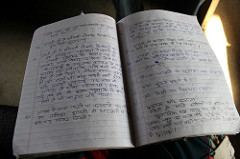Verb Tenses II: Present Progressive … and More on the Simple Present Posted by Nitya on Feb 18, 2017 in Hindi Language
Last week पिछले हफ्ते (pichhlay haftay), we looked at construction of the simple present tense सामान्य वर्त्तमान काल (saamaanya vartamaan kaal) for regular verbs क्रिया (kriya).
However, instead of moving to the simple past tense, I thought it would be useful to learn the present continuous/progressive तात्कालिक वर्त्तमान काल (taatkalik vartamaan) tense. As its name denotes, the तात्कालिक वर्त्तमान काल indicates that an action is still in progress.
Let us look at some examples उदाहरण (udaharan):
उदाहरण १ : If there is a sudden downpour just as you are stepping out for a quick errand, you rarely say:
“It rains!” बारिश होती है। (Baarish hoti hai.)
A more appropriate response would be, “It is raining!” बारिश हो रही है। (Baarish ho rahi hai.)
A more appropriate response would be, “It is raining!” बारिश हो रही है। (Baarish ho rahi hai.)
उदाहरण २:
Let’s say a husband calls out to his wife for some help.
If she says, “Main aati hoon.“/ “मैं आती हूँ। ” it means more like “I’ll be right there.”
This indicates that she intends to go and help him, but she still hasn’t set out to do so.
However, if she says, “Main aa rahi hoon.”/ “मैं आ रही हूँ।”
it means, “I’m coming.” or “I’m on my way.”
This indicates that she is on her way to help him.
उदाहरण ३:
Let’s look at another situation:
Friend 1: (speaking from inside the kitchen to a friend who is sitting in the living room):
समोसा खाओ।
(Samosa khaao.)
Eat some samosas.
Friend 2: हाँ खा रही हूँ।
(Haan, kha rahi hoon.)
Yes, I am eating.
However, if Friend 2 responds by saying:
हाँ, खाती हूँ।
(Haan, khaati hoon.)
This literally means “Yes, I eat,” but in this case implies that she intends to eat the samosas shortly.
The simple present tense is also used to show something that is habitual or routine.
1. मैं रोज़ जल्दी उठती हूँ।
(Main roz jaldi uthti hoon.)
I wake up early every day.
2.मैं शाम को चाय पीता हूँ।
(Main shaam ko chai peeta hoon.)
I drink tea in the evenings.
3. हम सर्दियों में नानाजी के घर रहते हैं।
(Hum sardiyon mein nanaji ke ghar rehte hain.
During winters we stay at our grandfather’s house.
4. माँ हर शुक्रवार को व्रत रखती है।
(Maa har shukravaar ko vrut rakhti hai.)
Every Friday, Mother keeps/observes a fast.
MINI LESSON
A sentence in the present progressive tense is constructed in the following manner:
Subject + verb root [ROOT मूल ] + रहा/रही /रहे + हूँ/हो /है/हैं (conjugated form of the auxiliary verb, “to be,” depending on the subject)
|
+ |
root + रहा/रही /रहे (raha/rahi/rahey)(conjugated form of the main verb) |
+ |
हूँ/हो/ है/हैं(hoon, ho, hai, hain)(conjugated form of the auxiliary verb, “to be,” depending on the subject) |
| Example 1: I am eating. (1st person, sing., fem.) | ||||
| Main मैं |
+ |
KHA rahi खा रही |
+ |
hoon हूँ |
| Example 2: I am eating. (1st person, sing., masc.) | ||||
| Main मैं |
+ |
KHA raha खा रहा |
+ |
hoon हूँ |
| Example 3: You are eating. (2nd person, sing., fem.) | ||||
| Tum तुम |
+ |
KHA rahi खा रही |
+ |
ho हो |
| Example 4: You are eating. (2nd person, sing., masc.) | ||||
| Tum तुम |
+ |
KHA rahey खा रहे |
+ |
ho हो |
| Example 5: You are eating. (2nd person formal, sing., fem./masc.) | ||||
| Aap आप |
+ |
KHA rahi/rahey खा रहीं/रहे |
+ |
hain हैं |
| Example 6: He/she is eating. (3rd person, sing. masc./fem.) | ||||
| Veh वह |
+ |
KHA raha/rahi खा रहा/रही |
+ |
hai है |
| Example 7: We are eating. (1st person, plural) | ||||
| Hum हम |
+ |
KHA rahey खा रहे |
+ |
hain हैं |
| Example 8: They are eating. (3rd person, plural) | ||||
| Vey वे |
+ |
KHA rahey खा रहे |
+ |
hain हैं |

Keep learning Hindi with us!
Build vocabulary, practice pronunciation, and more with Transparent Language Online. Available anytime, anywhere, on any device.
Share this:




